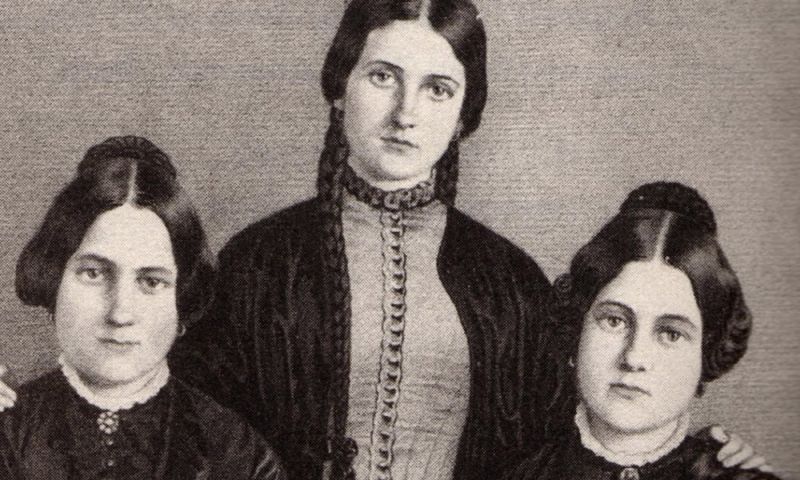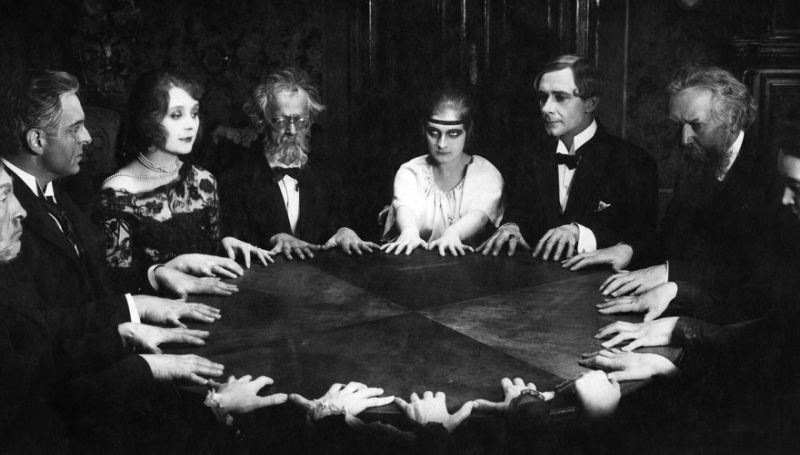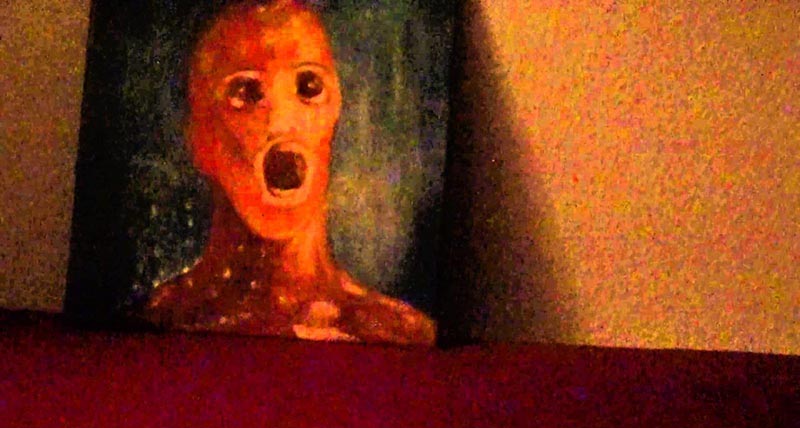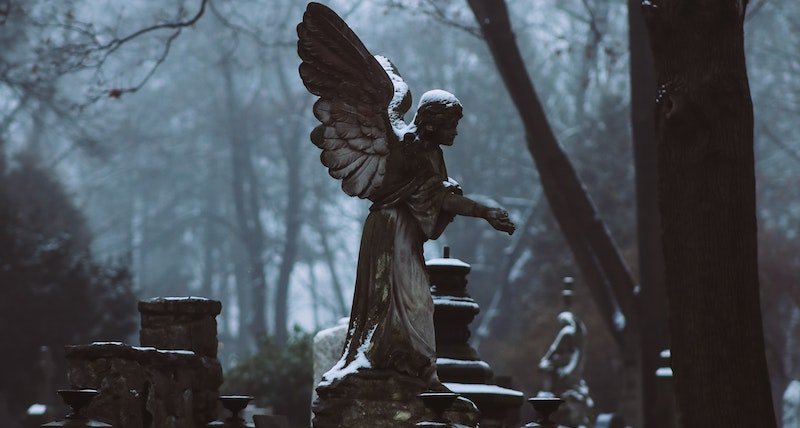This article aims to delve into the captivating history of mediumship, tracing its roots from ancient civilizations to its evolution in the modern world.
Mediumship, at its core, is the practice where certain individuals, known as mediums, claim to have the ability to communicate with the spirits of those who have passed away.
This communication can take various forms, including conveying messages from the deceased to the living, channeling spiritual entities, or demonstrating the soul’s continued existence after death.
Table of Contents
The History of Mediumship – A Brief Overview
Mediumship has been practiced in various forms across different cultures and periods, often within the context of religious or spiritual beliefs.
Understanding the history of mediumship is not merely an academic exercise.
It offers us a window into how our ancestors perceived the world beyond the physical and sought to understand the mysteries of life and death.
It allows us to trace the evolution of these beliefs and practices, to see how societal changes, scientific advancements, and cultural shifts have shaped them.
Furthermore, it provides context for the current perceptions and practices of mediumship, helping us understand why it continues to be a source of comfort for some and a subject of skepticism for others.
Related: The Anguished Man: The Haunting Tale of a Cursed Painting
In the following sections, we will journey through time, exploring the origins of mediumship in ancient civilizations, its rise to prominence in the 19th century, its evolution in the 20th and 21st centuries, and its intersection with science and belief.
We will also look at the individuals who have played significant roles in shaping mediumship as a practice, and address some frequently asked questions about mediumship.
Whether you’re a believer, a skeptic, or simply curious, this exploration of the history of mediumship promises to be an enlightening journey.

Mediumship in Ancient Civilizations
The practice of mediumship has roots that stretch back to the earliest civilizations.
In ancient times, the ability to communicate with the spirit world was often associated with shamans, priests, and priestesses who served as intermediaries between the human and spiritual realms.
In Ancient Egypt, for instance, priests and priestesses often performed rituals to communicate with the gods and the spirits of the deceased.
They believed in the concept of “Ka,” the spiritual double that survived after death, and mediums played a crucial role in guiding these spirits in the afterlife.
The Ancient Greeks also had their mediums, known as oracles.
You may also like: Mackenzie Poltergeist Tour: A Spine-Chilling Journey Through Edinburgh’s Haunted History
The most famous of these was the Oracle of Delphi, who served as a conduit for the god Apollo and provided prophetic messages to seekers.
The Pythia, the priestess who served as the oracle, would enter a trance-like state during which she would receive messages from Apollo.
In Ancient China, mediumship was practiced by the Wu, shamanic figures who could communicate with spirits.
They performed rituals and ceremonies to appease the spirits, predict the future, and provide guidance to the living.
History of Mediumship: Evolution and Practices
Over the centuries, the practice of mediumship has evolved significantly, shaped by cultural, religious, and societal changes.
In the Middle Ages, mediumship often fell under the umbrella of witchcraft and was viewed with suspicion and fear. Mediums were often persecuted, and their practices were driven underground.
In the 19th century, with the rise of Spiritualism, mediumship underwent a significant transformation.
The Spiritualist movement, which began in the United States and spread to Europe, embraced mediumship as proof of life after death. Mediums held séances, where they communicated with spirits in front of audiences.
This period saw the emergence of physical mediumship, where mediums produced physical evidence of spirit communication, such as rapping sounds, levitation, and the materialization of spirit forms.
The 20th century brought further changes to mediumship practices.
With the advent of new technologies, mediums began to use devices such as spirit boxes and electronic voice phenomena (EVP) recorders to communicate with spirits.
The focus also shifted from physical mediumship to mental mediumship, where mediums receive messages from spirits mentally, through clairvoyance, clairaudience, or clairsentience.
In the 21st century, mediumship continues to evolve. Today’s mediums often use their abilities to provide comfort and closure to those grieving the loss of loved ones.
They also work to educate the public about their practices, dispel misconceptions, and promote a better understanding of the spirit world.
Ultimately, the history of mediumship is a testament to humanity’s enduring fascination with the spirit world and the quest for answers about life, death, and what lies beyond.

The Rise of Mediumship in the 19th Century
The Fox Sisters and the Birth of Modern Spiritualism
The 19th century marked a significant turning point in the history of mediumship with the advent of the Spiritualist movement.
The Fox sisters were at the heart of this movement, whose experiences in the mid-19th century ignited widespread interest in spirit communication.
In 1848, in the small town of Hydesville, New York, sisters Margaret and Kate Fox began to hear mysterious rapping noises in their home.
Keep exploring: Communicating With the Deceased: Understanding and Interpreting Messages
They developed a code to communicate with the entity causing the noises, which claimed to be the spirit of a peddler who had been murdered and buried in the house.
News of the Fox sisters’ communication with the spirit world spread rapidly, and they quickly became national celebrities. They held public séances, demonstrating their mediumship abilities to captivated audiences.
Despite later controversies and admissions of fraud, the Fox sisters profoundly impacted the perception of mediumship.
They had, it seemed, provided tangible proof of life after death, sparking a surge in spiritualist activity across the United States and, later, Europe.
Famous Mediums in the 19th Century
The rise of Spiritualism in the 19th century saw the emergence of several notable mediums that left their mark on the practice of mediumship.
One such medium was Daniel Dunglas Home, a Scottish medium known for his remarkable physical phenomena. Home reportedly levitated, handled fire without being burned, and produced spirit hands that could touch and be touched.
His séances were attended by the elite of the time, including Napoleon III and the Russian Tsar Alexander II.
Leah Fox Underhill, the eldest of the Fox sisters, also gained fame as a medium. She managed the careers of her younger sisters and conducted her own séances.
Her clients included Horace Greeley, the editor of the New York Tribune, and James Fenimore Cooper, the renowned author.
Corine Chilton, another prominent medium of the era, was known for her ability to produce physical manifestations of spirits.
She was one of the few mediums which allowed herself to be investigated by scientists, contributing to the early study of mediumship.
Emma Hardinge Britten was an influential medium and writer who played a crucial role in the spread of Spiritualism.
She authored several books on the subject and is credited with outlining the Seven Principles of Spiritualism, which continue to guide the philosophy of many Spiritualist churches today.
The 19th century was a pivotal period in the history of mediumship.
The experiences of the Fox sisters and the rise of Spiritualism brought mediumship into the public eye.
At the same time, the work of mediums like Daniel Dunglas Home, Leah Fox Underhill, Corine Chilton, and Emma Hardinge Britten helped shape the practice of mediumship and its perception by society.

Continued Growth and Skepticism
When it comes to the history of mediumship, the 20th century was a period of both growth and skepticism. As the practice continued to evolve, it faced increased scrutiny from both the scientific community and the public.
The early part of the century saw the establishment of organizations dedicated to the scientific study of psychic phenomena, including mediumship.
The Society for Psychical Research in the UK, founded in 1882, and the American Society for Psychical Research, established in 1885, were among the leading institutions conducting rigorous investigations into claims of spirit communication.
These organizations attracted prominent members, including Nobel laureates and leading scientists of the time. They conducted experiments under controlled conditions and published their findings in peer-reviewed journals.
However, despite these efforts, the results were often inconclusive and met with skepticism from the broader scientific community.
Recommended read: Ed and Lorraine Warren: The Fascinating Story of the World’s Most Renowned Paranormal Investigators
And because of that, the practice faced considerable skepticism during the 20th century.
High-profile cases of fraud, such as that of Mina Crandon, also known as “Margery,” did much to fuel this skepticism.
Crandon, a Boston medium popular in the 1920s, was caught using tricks to simulate spirit contact, including using a telescopic finger made of animal liver.
These scandals led to a decline in the popularity of physical mediumship and increased public skepticism.
However, the practice continued to find followers. The Spiritualist Church, which recognized mediumship as a central part of its belief system, continued to grow.
By the mid-20th century, there were over 300 Spiritualist churches in the UK alone.
The practice also found a place in the New Age movement, which emerged in the latter part of the 20th century.
This movement, characterized by a blend of Eastern and Western spiritual traditions, incorporated elements of spiritualism, including belief in spirit communication and the afterlife.
Today, many New Age practices, such as channeling and spirit communication, are directly linked to mediumship.
Pioneers of 20th-Century Mediumship
The 20th century, while marked by skepticism, also witnessed the rise of several influential mediums who left indelible marks on the field of mediumship.
Arthur Ford, a luminary of the early 20th century, is remembered for his extraordinary séances, which attracted a star-studded audience.
Ford’s fame skyrocketed when he claimed to have communicated with the spirit of the legendary magician, Harry Houdini.
This alleged contact with Houdini, who had been a fervent debunker of fraudulent mediums during his life, sparked a media frenzy and cemented Ford’s place in the annals of mediumship.
Leonora Piper emerged as a beacon of Spiritualism, earning the moniker “white crow” – a term coined by the philosopher William James to signify a single event that could disprove a general statement.
Piper’s trance mediumship was so compelling that it drew the attention of the Society for Psychical Research, which conducted extensive studies on her abilities.
William James, a pioneering psychologist and philosopher, was among the researchers who studied Piper and found her abilities noteworthy.
Keep exploring the same topic: What Is Spontaneous Psychokinesis? Understanding the Psychology Behind Poltergeist Manifestations
Known as the “Sleeping Prophet,” Edgar Cayce brought a unique flavor to mediumship.
Cayce’s readings, delivered in a trance state, covered many topics, from reincarnation and lost civilizations like Atlantis to holistic health remedies.
His work continues to inspire and intrigue people even today, with many of his readings preserved and studied by the Association for Research and Enlightenment.
Hailing from the UK, Estelle Roberts was a prominent medium known for her partnership with her spirit guide, Red Cloud.
Roberts’ public séances and private readings demonstrated her mediumship abilities and made her a central figure in the UK’s Spiritualist movement.
Her work with Red Cloud was so influential that it continues to inspire Spiritualist mediums today.
These trailblazers and many others navigated the challenges of their time to shape mediumship practice in the 20th century. Their contributions fostered the growth of mediumship and helped it gain acceptance as a spiritual practice.
Mediumship in the 21st Century
Mediumship in the Modern World
As we navigate the 21st century, the practice of mediumship has adapted to fit our modern society, taking on a more personal and therapeutic role.
In contrast to the public séances of the past, today’s mediums often provide individual readings, offering a personal touch to those seeking solace, closure, or a sense of connection with departed loved ones.
This shift towards a more intimate setting has allowed mediumship to evolve into a form of spiritual counseling, providing comfort to those navigating the complexities of grief.
The therapeutic potential of mediumship has gained recognition in recent years.
A study by the University of Northampton found that some bereaved individuals reported benefits from visiting mediums, including reduced grief intensity and a renewed sense of purpose.
However, the perception of mediumship in the 21st century is far from uniform.
Skepticism persists, particularly within the scientific community. Critics maintain that there is no empirical evidence to support the existence of spirits or the ability to communicate with them.
On the same topic: Psychic vs. Medium: Understanding the Difference Between a Psychic and a Medium
They propose that the experiences reported by mediums and their clients can be attributed to psychological phenomena, such as the ideomotor effect or the power of suggestion.
Yet, alongside this skepticism, there is a growing acceptance of spiritual experiences and an appreciation for the subjective value that mediumship can offer.
Many individuals who consult mediums are not necessarily driven by a belief in the supernatural, but rather by a desire for healing and connection.
For these individuals, the validation of mediumship is not found in scientific proof, but in the comfort and closure it provides.
This shift in perception reflects a broader trend towards a more holistic understanding of well-being, where emotional and spiritual health are recognized as integral components of overall wellness.

Famous Modern Mediums
The 21st century has seen the rise of several notable mediums who have gained recognition for their work.
John Edward is perhaps one of the most well-known mediums today. He has hosted several television shows, including “Crossing Over with John Edward” and “John Edward Cross Country,” where he provides readings for audience members and celebrities.
Theresa Caputo, also known as the “Long Island Medium,” is another prominent medium. She has a popular reality TV show where she provides readings for clients and communicates with their deceased loved ones.
James Van Praagh is a medium and spiritual teacher who has written several books on mediumship and spirituality. He has also produced television shows based on his work, including “Ghost Whisperer.”
Tyler Henry, the “Hollywood Medium,” is a younger medium who has gained fame for his readings for celebrities. His television show, “Hollywood Medium with Tyler Henry,” has brought mediumship to a new generation of viewers.
These mediums, along with many others, are shaping the face of mediumship in the 21st century.
They are bringing the practice into the mainstream, demonstrating its potential value for healing and connection, and sparking conversations about the nature of life, death, and what lies beyond.
The timeline table below outlines some key moments in the history of mediumship:
| Time Period | Event | Description |
|---|---|---|
| Ancient Times | Mediumship in Ancient Civilizations | Mediumship practices were present in ancient civilizations such as Egypt, Greece, and China. Priests, priestesses, oracles, and shamans served as intermediaries between the human and spiritual realms. |
| Middle Ages | Persecution of Mediums | During the Middle Ages, mediumship often fell under the umbrella of witchcraft and was viewed with suspicion and fear. Mediums were often persecuted, and their practices were driven underground. |
| 1848 | The Fox Sisters | Margaret and Kate Fox from Hydesville, New York, claimed to communicate with the spirit of a deceased peddler, sparking the Spiritualist movement in the United States. |
| 19th Century | Rise of Spiritualism | The Spiritualist movement embraced mediumship as proof of life after death. Mediums held séances, where they communicated with spirits in front of audiences. Notable mediums of this era include Daniel Dunglas Home and Leah Fox Underhill. |
| Early 20th Century | Scientific Investigations | Organizations like the Society for Psychical Research in the UK and the American Society for Psychical Research in the US conducted investigations into claims of spirit communication. |
| Mid 20th Century | Decline and Skepticism | High-profile cases of fraud, such as that of Mina Crandon, fueled skepticism and led to a decline in the popularity of physical mediumship. |
| Late 20th Century | New Age Movement | Mediumship found a place in the New Age movement, which incorporated elements of spiritualism, including belief in spirit communication and the afterlife. |
| 21st Century | Modern Mediumship | Mediumship continues to evolve, with mediums often working in a more personal, one-on-one setting. Notable modern mediums include John Edward, Theresa Caputo, James Van Praagh, and Tyler Henry. |
Science and Belief
The intersection of mediumship and science is a complex and fascinating area. Over the years, numerous studies have been conducted to investigate the claims of mediums, often with mixed results.
Some studies, such as those conducted by the Windbridge Research Center, have found statistical evidence suggesting that certain mediums can provide information about deceased individuals that they could not have obtained through normal means.
Other researchers, like Dr. Julie Beischel, have conducted controlled experiments with mediums and reported positive results.
However, these studies are often met with skepticism from the broader scientific community.
Critics argue that the studies are flawed, citing issues such as lack of proper controls, risk of fraud, and the influence of cognitive biases like the Barnum effect, where individuals see specific personal meaning in vague or general statements.
Mediumship and Beliefs about the Afterlife
Mediumship is closely tied to beliefs about the afterlife. For many, the ability of mediums to communicate with the deceased provides reassurance of life after death and offers comfort in the face of grief.
Different cultures and religions have varying beliefs about the afterlife, often shaping the practice and perception of mediumship.
In Spiritualism, for instance, mediumship is seen as evidence of the continuity of life after death. The messages received from spirits are often comforting and reassuring, reinforcing the belief in a peaceful and loving afterlife.
However, it’s important to note that belief in mediumship does not necessarily equate to belief in a particular type of afterlife. Many people consult mediums for personal reasons, such as seeking closure or healing, rather than out of religious or spiritual beliefs.
In this exploration of the history of mediumship, we’ve journeyed from the ancient civilizations that first practiced forms of mediumship, through the rise of Spiritualism in the 19th century, and into the modern era where mediumship has found a place in contemporary society.
We’ve seen how mediumship has evolved and adapted over the centuries, shaped by societal changes, cultural shifts, and scientific advancements.
We’ve also looked at the individuals who have played significant roles in shaping mediumship as a practice, from the Fox sisters and Daniel Dunglas Home to modern mediums like John Edward and Theresa Caputo.
Their stories highlight the enduring fascination with the spirit world and the quest for answers about life, death, and what lies beyond.
The history of mediumship is a testament to humanity’s enduring desire to seek connection, understanding, and comfort in the face of the unknown.
As we move forward, it will be fascinating to see how mediumship continues to evolve and adapt to the changing world.
Whether you’re a believer, a skeptic, or simply curious, the journey into the world of mediumship is fascinating, offering insights into the human experience and our timeless quest for understanding.
Frequently Asked Questions
Are there famous mediums in history?
Yes, there have been many famous mediums throughout history. Some notable examples include the Fox sisters, Daniel Dunglas Home, Leonora Piper, and Arthur Ford. More recent famous mediums include John Edward, Theresa Caputo, James Van Praagh, and Tyler Henry.
What role does mediumship play in spiritualism?
In Spiritualism, mediumship is seen as evidence of life after death. Mediums are believed to communicate with spirits, providing messages demonstrating the soul’s continuity.
Is mediumship scientifically proven?
The scientific study of mediumship has produced mixed results. Some studies suggest that certain mediums can provide information they could not have obtained normally. In contrast, others argue that these findings result from flawed methodologies or cognitive biases.
Is mediumship a recognized profession?
Yes, mediumship is a recognized profession. Many mediums provide readings for clients, often in a one-on-one setting. Some mediums also write books, teach workshops, or appear on television.
What is mediumship?
Mediumship is the practice where certain individuals, known as mediums, claim to have the ability to communicate with the spirits of those who have passed away.
How does mediumship work?
Mediums typically describe their work as a form of intuitive perception. They may receive messages from spirits through words, images, feelings, or impressions, which they then convey to the living.
When did mediumship appear for the first time?
The mediumship practice can be traced back to ancient civilizations, where shamans, priests, and priestesses were intermediaries between the human and spiritual realms.




